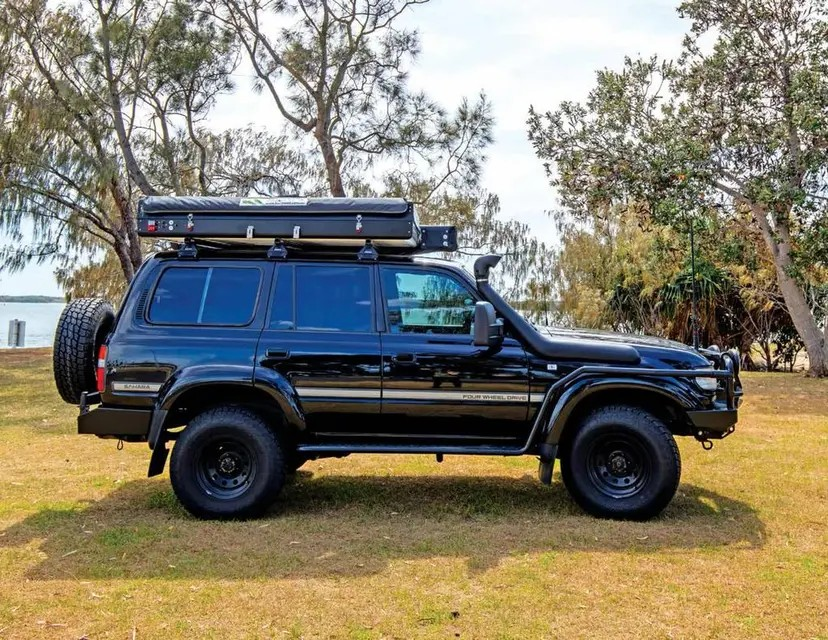
Roof top tent Review: Bundutec Bundutop
The South African-made Bundutec Bundutop goes up or down in 20 seconds with the press of a button, retains bedding while you travel, and features a thicker foam mattress than most.
Is it time that comfort and convenience came first?
Picture this: a rooftop tent that goes up and down with the press of a button. When I was on the Gold Coast recently, the prospect of seeing such a tent in the flesh was too much, so I arranged to catch up with Bundutec Australia to see the South African-made Bundutop in action. I saw more than I’d bargained for — two tents, one on the white Land Rover Defender belonging to Ian, who runs Bundutec Australia, and the other on the black Land Cruiser of well-known personality Luke Eglin, who you might recognise from Married At First Sight.
Well-versed in reality television, Luke is fluent off-road, whether in the Victorian High Country or along Queensland’s white sand beaches. Nor is Ian a stranger. After clocking 30,000km in a Defender equipped with a Bundutop tent on a journey through South Africa, Namibia, Botswana, Zimbabwe, and Mozambique (not necessarily in that order), Ian now views the tracks throughout Africa as “a combination of Cape York and the Canning Stock Route, but with wild animals.”
Mods and Fitment
Bundutec’s signature Bundutop tent consumes most of the roof rack space, but it’s compatible with roof-carried accessories in a way many other hard-lid tents are not.
A solar panel of up to 300W can be drilled and bolted to the roof, which can take a dispersed 25kg. There’s a pre-wired Anderson plug to receive the charge, its wiring threaded discreetly down the tent’s internal arm to come out at a second plug, itself connected to a solar regulator feeding the car’s auxiliary battery. If you park outside, a large roof-mounted panel should keep the battery sufficiently charged to run the car fridge 24/7.
The riveted aluminium of the Bundutop is also strong enough to have awning mounts directly attached to it. This is a lifeline for owners of certain roof racks or utes with canopies who can’t have a rooftop tent and a shaded outdoor area simultaneously any other way. If you mount an awning this way, your distributor may be able to relocate the over-centre clips securing the tent lid down so that there are none on the awning side.
Bundutec also make various other tent add-ons, such as ‘The Added Room’, a further shelter to expand the living space. They have released a few such additions and are working on more. Many attach with sail tracking, which is to be epoxied on where required.
The underside of the tent has six north-to-south structural aluminium bars responsible for bearing the load, which continue right to the ends. These bars sit flush against horizontal crossbars after installation, with no immediately obvious means of connection — at first glance, it appears superglued on. In reality, the tent is connected with bolts through direct captive holes in the tent base, secured underneath within the hollow interior of the roof rack rails with a cam lock nut.
“These bars sit flush against horizontal crossbars after installation, with no immediately obvious means of connection”
These installation procedures do require confidence on the tools. If you’re handy yourself, you will manage, but if not, have a discussion with your local dealer to see if they can assist.
On the Road
The tent is made of riveted aluminium, with black paint on the sides. The roof is left as a raw aluminium sheet so it can reflect heat rather than absorb it, keeping the interior cool. This makes a nap during the day or a morning sleep-in easier.
The 300 gsm military-grade UV-treated rip-resistant canvas connecting the lid and base is tucked inside during travel mode. Rubber seals line the underside of the lid. Four over-centre latches press these tightly during transit, keeping wind and dust out of the interior. A protruding downward-angled lip around the lid adds additional shelter over where the two halves meet.
The tent presents a 30 cm-tall flat slab to the wind, making it comparable to side-folding rooftop tents but less aerodynamic than fibreglass-moulded hard lids. However, it compensates for that with its healthy 74kg, some 25 kilograms lighter than other clamshells out there. Shaving off 25, or even just five kilograms, reduces the tent's impact on vehicle handling, mitigating tilt when rounding corners and increasing safety in off-road environments. It also opens up the tent to some smaller 4WDs.
Setting It Up
It’s not unusual to have to work hard to set up a rooftop tent, but the Bundutec Bundutop avoids this physicality with its easy, winch-operated opening. This ensures all travellers are capable of set-up and pack-up, maintains a good mood in the morning, and makes it more feasible to rock up to camp late.
The German-supplied Adendorff winch is operated with up and down buttons on the tent's base; full open to full close takes approximately 20 seconds, and vice versa. The winch drum winds on and off narrow Dyneema rope. From its drum, four threads run to a protected hub in the ceiling where four pulleys then direct these threads to the elbowed metal arms in the tent corners; here, the Dyneema threads into a series of bearings and pulleys, such that winching in and out opens and closes the arms, and therefore the tent.
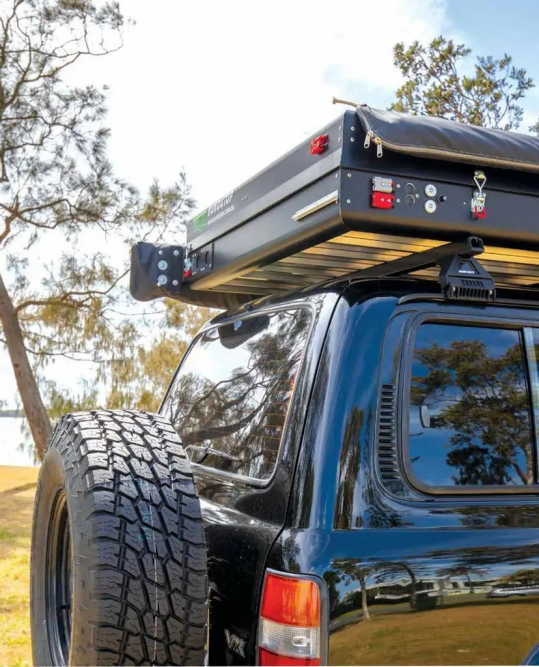
An upper Anderson plug can take solar input, while the lower red plug directs that to charge the battery.
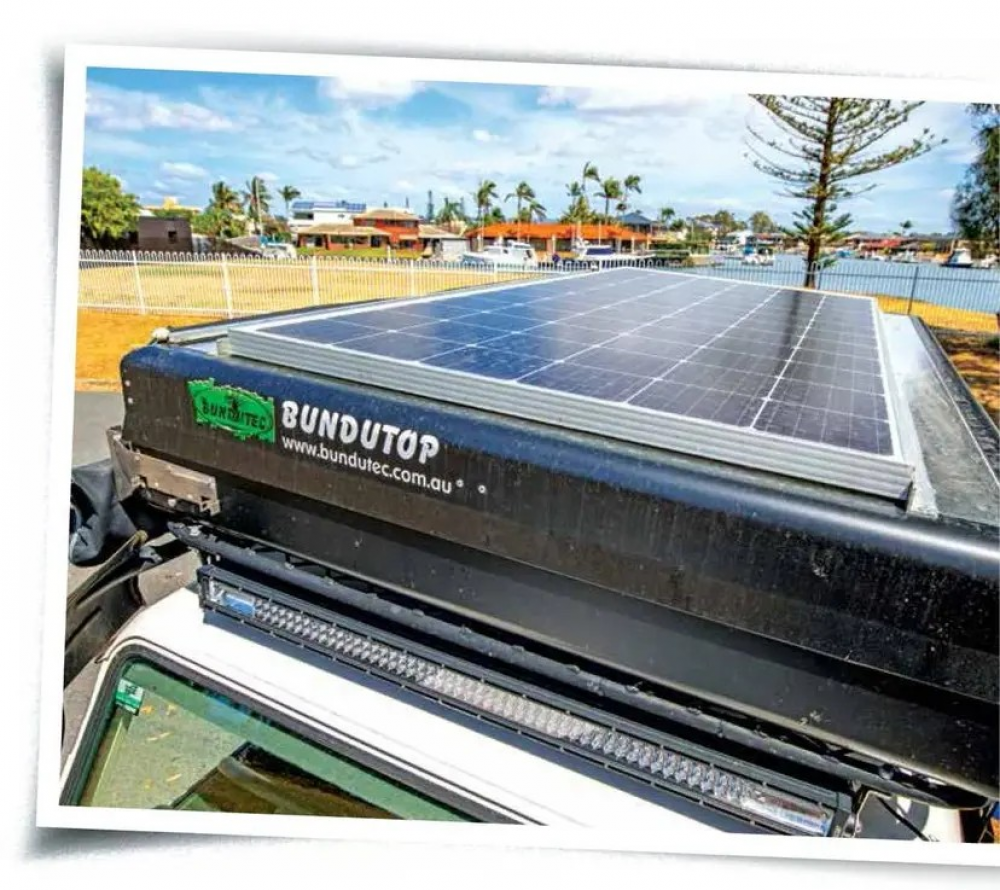
A 300W solar panel sits on the roof of Ian's Defender.
When set up, the tent features an integrated 360-degree hat-brim awning with a 45-degree downward-slanting angle. The tent’s internal corner arms bear rods pointing outwards, which exit through holes in the canvas to connect to the corners of this awning. Narrower Dyneema rope connects these awning corners and is also threaded through loops in the underside of the awning and connected to flat aluminium bars in internal canvas sleeves, such that when the arms fold or unfold with the winch, the awning sets up automatically as well. The awning Dyneema also helps to pull in the fabric during pack-up.
The winch is 12V-powered via an Anderson plug on the tent body fed by an auxiliary battery in the customer’s car. You can connect to power each time or have it permanently hardwired. In my mind, connecting each time is the best option. That way, you’ll never accidentally turn on the internal fans, and you’ll never be able to instantly press the up button without thinking. If you did that without first undoing the four over-centre latches, you would risk bending the internal arms or damaging the latches.
Readers may have a few anxieties about the electrical automation of the tent, but Bundutec has addressed these pretty well. Limit switches stop the tent from trying to open or close further than it should, so you needn’t fear holding the button for too long. Ian says there hasn’t been a winch failure in the last eight years. He also notes that should the winch’s electricals play up, there are covered positive and negative terminals next to the up and down buttons that can be directly attached to a battery, like a car jump start. The fuse is clearly labelled and easily accessible for replacement (you’d need to carry spares when travelling remotely). All other circuitry is located internally, in a protected box that can be opened if required. There’s no means of manually cranking the tent open and closed, but if it came to it, you could push it down if it was playing up while you were out bush, then deal with the problem back in town.
The tent can close with pillows and a doona inside, saving time, freeing up car space, and keeping gear clean and organised. On pack-up, all windows must be unzipped and folded onto the mattress, so they don’t protrude, and to help let air out as the lid compresses. It pays to pause when the tent is almost closed and ensure all canvas is tucked in before forming the seal.
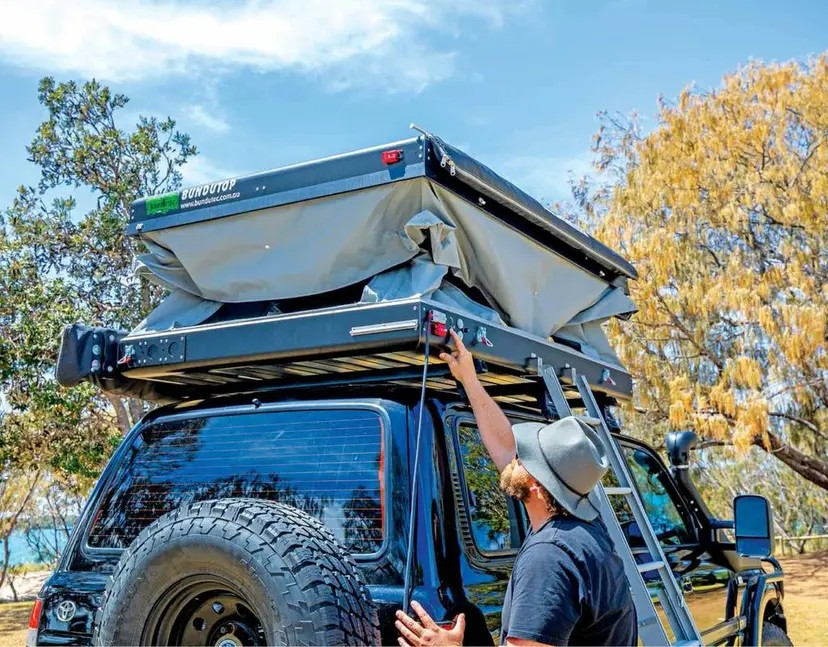
Luke lowering the tent — it pays to pause before it's down to ensure all the canvas is tucked in
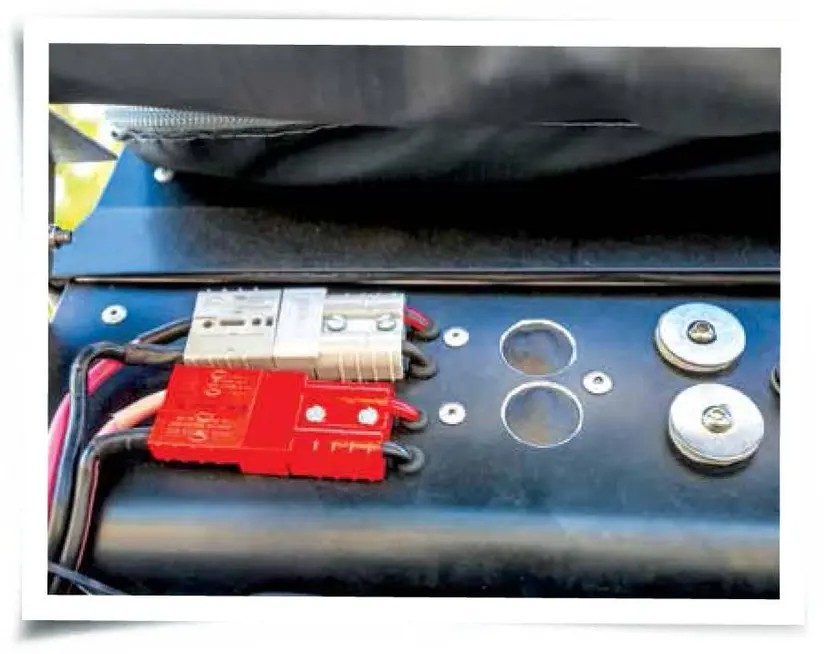
The grey Ando plug supplies the power to the winch, with the in and out buttons next to the manual override terminals.
The Stairway To Heaven
The two-part ladder is not permanently attached to the tent. While it can technically be stowed under the mattress, many will store it in its canvas bag in the car. At 135cm long when folded down, it will slot into most vehicles widthways. Packaging it away each time is an effort, but it keeps the tent’s weight down.
Any of the tent’s four windows are eligible doors, and the ladder can be mounted under whichever one the bracket mounts are fixed. The side windows will be the most logical ladder location for most 4WDs, but this being a non-expanding hard-lid tent, the ladder may block whichever door it is nearest.
On one end, the ladder has hooked ends that slot into holes in the bracket mounts; to be removed, the ladder must be lifted upwards, meaning all weight applied in climbing holds it yet more firmly in place. The ladder does not, as standard, lock at various fixed lengths like other ladders — instead, the feet are left without rubber guards so they will dig into grass or dirt. However, some sites at caravan parks and free camps may have you camping on concrete, where the dig-in feet won't work. The solution is to drill a hole so a carabiner can lock the ladder at a fixed length on both sides.
The ladder has flat-topped rungs parallel to the ground, not angled with the ladder. However, the ladder can be reversed, to bring rounded rungs into play, if that is your preference. When in place, the two sides of the ladder rest firmly against each other, allowing for no flex or bowing as weight is applied. Anti-slip grooves veritably grasp your feet.
Life Inside
Inside the tent, there’s 93cm of headroom all around, except for a few lower parts. The mattress measures 200cm long and 125cm across. With the non-slanted ceiling, the length will be sufficient for those around 6ft to lie in, without leaving much room for shoes or loose items. However, compared to the rest of the market, the width of the mattress is a tad narrow. For an individual, 125cm is plenty, but for a pair, it will come down to how much space each needs to spread out. There’s a king-sized Bundutop available for an additional cost if you feel you need the space.
The high-density foam mattress, at 100mm thick, is thicker by 20 to 50mm than 95 per cent of others on the rooftop tent market. This makes a big difference, and you’ll be able to have a good night’s sleep without waking up with a bad back and pins and needles. Underneath the mattress, the surface is solid and flat, as it should be.
There are four or so bolt heads against the material, but you won’t be able to detect them. To increase the comfort even further, you can pick up a fitted cotton sheet from Drifted Off Linen, which makes them specifically for the Bundutec range.
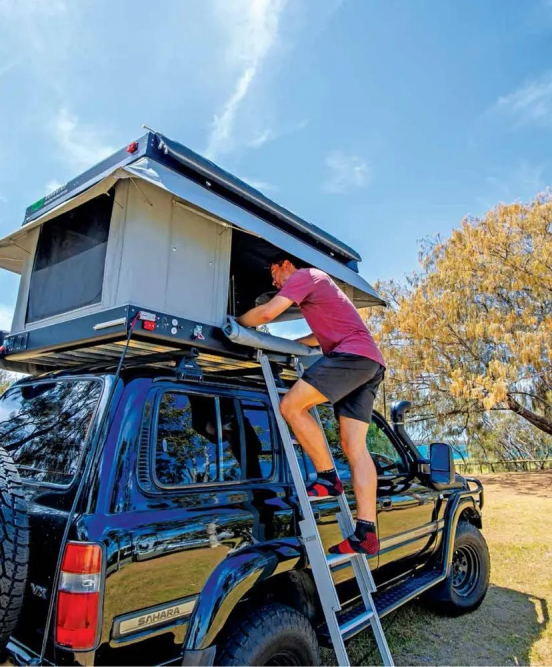
Sam climbs the sturdy flat-rung ladder
“To be removed, the ladder must be lifted outwards, meaning all weight applied in climbing holds it yet more firmly in place”
There’s one pocket on either end of the tent, so there’ll always be a pocket handy whichever side you lay your noggin. A cigarette lighter socket provides 12V power inside. The 12V connection also powers a magnetic light placed on the central hub of the ceiling, which alleviates the need to wear a headtorch or carry a torch or phone light while also trying to climb a ladder and carry gear. Being central, it won’t work well for reading on your back while lying down.
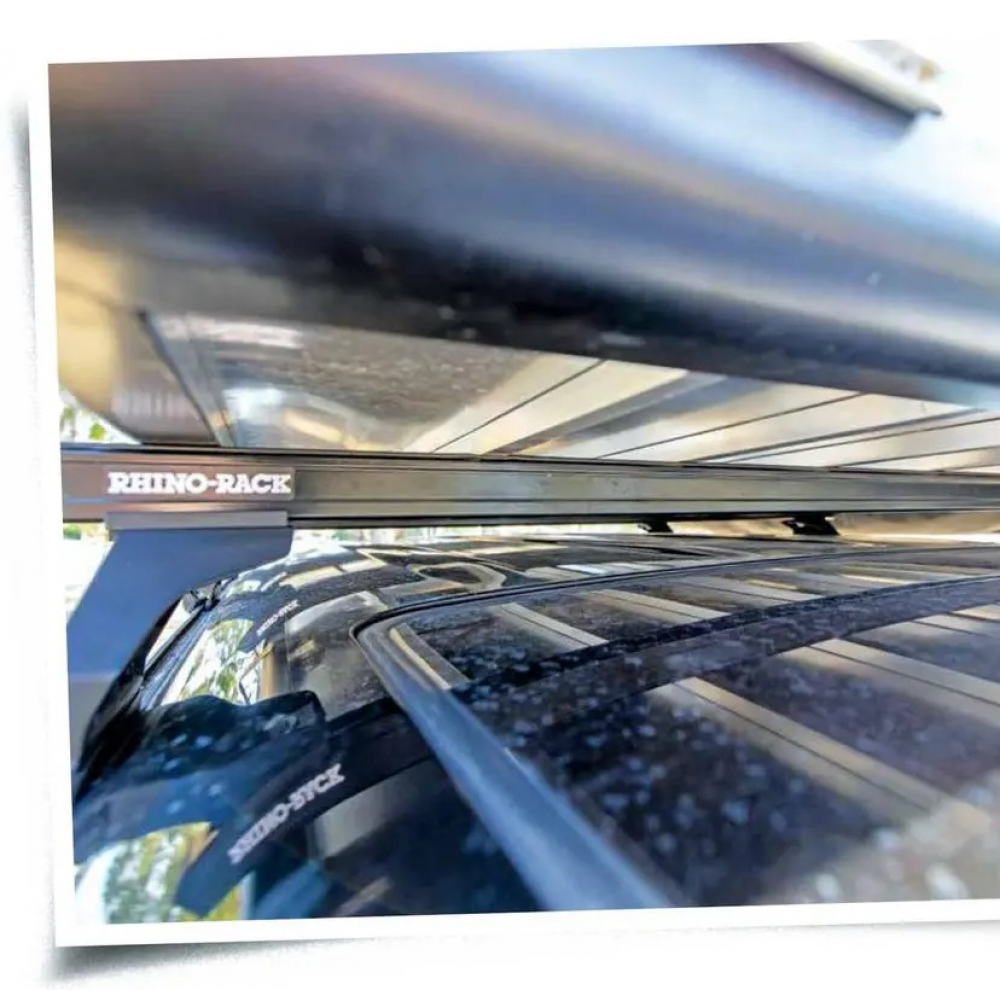
It really looks super glued on at first glance
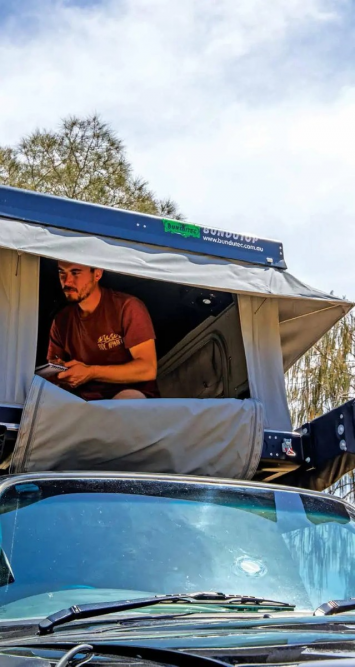
Examining the inside of the tent
“Airflow is impressive, with four large windows letting in not just 360-degree views, but a nice cross breeze”
Inside, where the poles holding out the awning enter the canvas and connect with the internal arm, there are no eyelets. This is a deliberate decision by Bundutec, who say that eyelets form a weak point due to crimping. Instead, the holes here are burned with a hot spike to make the canvas hard.
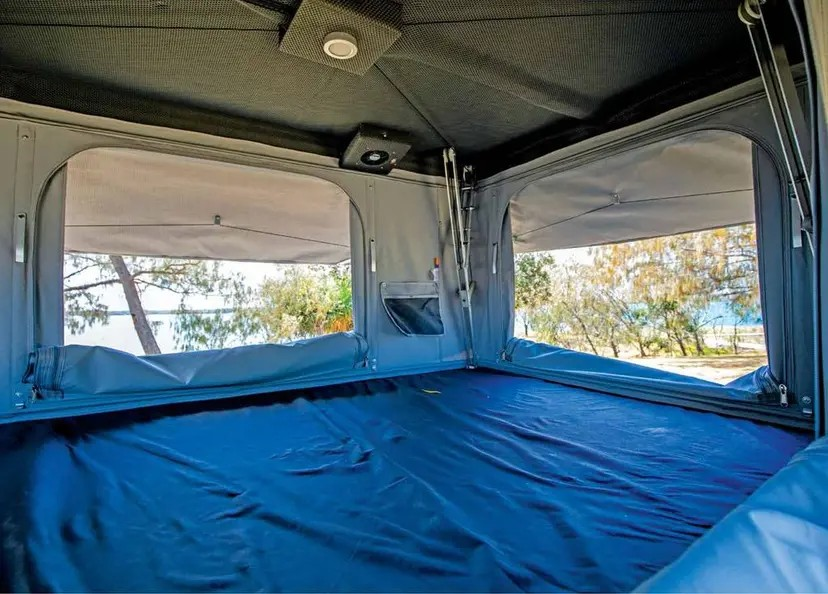
There's over 90cm of headroom all around
Withstanding All Weather
The insulation in the ceiling lining will retain body heat when it’s cold, and its foam backing will help to reduce condensation above the mattress. On the other hand, for hot, humid nights, the tent features two switch-operated 12V brushless fans down one end. Even without these, airflow is impressive, with the four large windows letting in not just 360-degree views, but a nice cross-breeze.
In many tents, the mesh and canvas layers of the doors are separate flaps. However, with the Bundutop, the two are part of the same flap, which has an inner and an outer zip. The outer zip opens the entire door, while the inner zip peels back the canvas from the mesh. Both layers are connected to the main fabric at the bottom, making the zips upside-down U-shapes.
This arrangement is clever for a few subtle reasons. One, it allows you to unzip just one zip to enter and exit — most tents require you to undo two. Two, there’s no point in rolling up the mesh but in having the canvas zipped up. Bundutec has eliminated this pointless option. Three, it enables comfortable wet-weather camping. When a window flap is connected at the bottom, the zips can be zipped partway up the sides, and the canvas folded over. Having the windows partly done up like this allows airflow while also preventing slanting rain from coming in under the 360-degree awning and penetrating the lower half of the windows.
The risk with any awning or window shelter is that it’ll flap noisily in the wind. However, the taut Dyneema cord threaded to the awning’s underside and the metal rods holding out the corners prevent the canvas from rustling against the tent body. At the same time, the relative narrowness of the ‘hat brim’ also prevents the canvas from truly catching the wind and cracking like a whip. The absence of a poly/nylon fly removes a common cause of sleepless nights too!
In Summary
In Australia, the Bundutop comes with a one-year warranty. Ian, however, backs his product beyond that timeframe. It’s best to discuss the specifics of the warranty with individual dealers and what will happen if issues arise beyond it. Ian says most parts are replaceable locally, at stores like Bunnings and Jaycar.
The main business is based in Queensland’s Gold Coast, with delivery Australia-wide, but there is a dealer in Tully, plus dealers in NSW’s Hunter Region, Blue Mountains, Coffs Harbour, Bathurst and Tamworth, and in Melbourne, Adelaide and Perth.
The Bundutop gives you a much more comfortable mattress than most competition, takes the hassle out of afternoon set-ups when you’re not in the mood, and gets your day off to the right start with a quick getaway. The Bundutop would be a great upgrade for those who’ve done their time in a cheaper fold-over RTT's, or those with a sense of how important comfort is in keeping you motivated to see the country, be it South Africa or Australia.
Hits
-
360-degree views and airflow
-
A thicker, softer mattress than most RTTs
-
Fully automated set-up, including awnings
-
Rapid-fire pack-down times for quick getaways
-
Ability to mount solar panel and awning direct to tent
-
Good at withstanding sun, wind and rain
-
Light for an aluminium tent
-
Can leave bedding in
Misses
-
Mattress not the widest for couples
-
Ladder takes up room in the car
-
Potential to do damage if winch-out when latches on
-
Rope would be fiddly to fix if it ever broke
-
Mods and installation may require drilling
Rooftop Tent Specifications
Weight: 74kg
Shell material: Riveted aluminium
Canvas material: 300gsm military-grade UV-treated rip-resistant canvas
Ladder: Two-part aluminium, 135cm when contracted
Roof load capacity: 25kg
Style: Hard-lid box with automated opening
Dimensions
External size (closed): 2100mm (L) x 1350 (W) x 300mm (H)
External size (opened): 2100mm (L) x 1350 (W) x 1030mm (H)
Mattress: 100mm thick high-density foam measuring 2000mm x 1250mm, fitted cotton sheet available
Internal headroom: 93cm, even throughout
Electrical Features
2 x 12V fans, internal cig point, ceiling light, pre-wired Anderson plug allowing for the addition of a roof-mounted solar panel to charge the car’s auxiliary battery, automatic opening powered by Anderson plug using German-supplied Adendorff winch and Dyneema rope in the pulley system
More Information - Bundutec Australia, Biggera Waters
Ready to Upgrade Your Touring Setup?
Find your dream van online at OnlyVans.com.au! If the Bundutec Bundutop’s comfort and convenience have inspired your next trip, explore our selection of camper trailers for sale and roof-top-ready rigs designed for stress-free touring.
We have great deals on caravans for sale including used caravans and caravans from private sellers. You can also find motorhomes for sale, camper trailers, and pop top caravans. No matter how you like to travel, we've got you covered.
This article was written by Sam Richards, with photos by Emma Warren, and previously appeared at TradeRVs.com.au, now powered by OnlyVans.com.au.
Found your perfect purchase? Let’s make financing just as easy!
Work with Australia’s best-reviewed finance broker for a great deal and a stress-free experience. With 3,000+ glowing Google reviews, you can trust you're in good hands! See what our happy customers say in Credit One reviews, or jump right in and crunch the numbers with our handy loan repayment calculator. Your ideal financing solution is just a few clicks away!